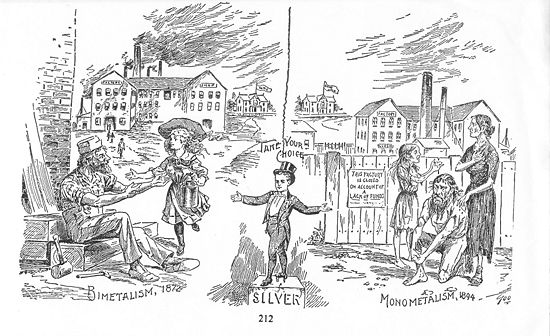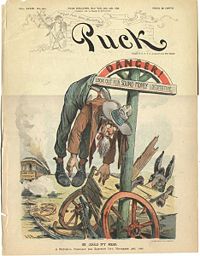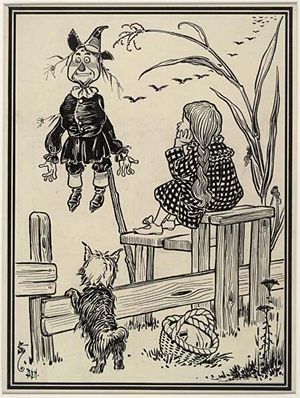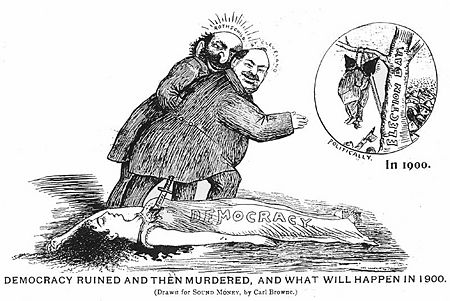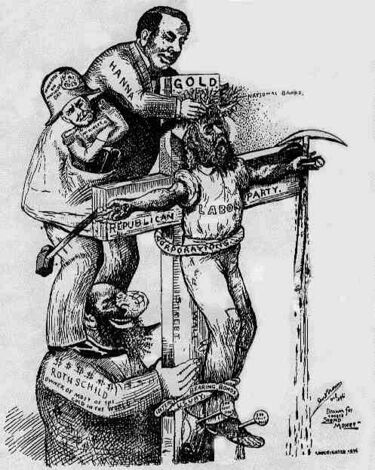Populist Party
The Populist Party (formally, The People's Party) was an American third party that flourished 1890-96. Based on a coalition of wheat farmers in the Plains states, cotton tenant farmers in the deep South, silver miners in the West, and coal miners in the Midwest, it carried several states in the 1892 election. It suffered heavy losses to the resurgent Republican party in 1894, and in 1896 endorsed the Democratic party candidate, William Jennings Bryan. It virtually disappeared after its defeat in 1896.
Origins
The rhetoric and social critique of the Populists originated long before the 1890s, and found fullest expression in the Greenback movement of the 1880s.[1] Ritter (1997) argues that Populism was the latest and most widespread reincarnation of the anti-monopoly movement. It believed in an alternative political economy tradition rooted in the republican traditions of Jeffersonian Democracy and Jacksonian Democracy. The goal was to preserve economic opportunity and political participation for all Americans in the face of anti-republican forces led by the bankers. Ritter sees anti-monopolism as a strong, coherent tradition which offered an alternative to corporate liberalism, but which failed because of the constraints of the Third Party System and poor strategic choices by poorly coordinated radical politicians. [2]
In 1890-92 the Farmers' Alliance, a farmers' political organization that spread widely in the cotton and wheat belt, became the basis of the Populist party.
The party was organized at St. Louis in February 1892 and represented, in general, three groups: 1) Western agrarians who had achieved some political success by means of independent parties in the congressional and state elections since 1890; 2) Southern agrarians who, through the Farmers' Alliances, had sought to capture their state Democratic organizations as a means of achieving their aims; and 3) representatives of several labor unions and other reform groups. Farmers' Alliance leaders from Southern states generally opposed the formation of a third party, fearing that such action would endanger white supremacy in the South. Leadership in the contest for control went to Western agrarians and remained in their hands during the early years of the party's history. This raised the problem of achieving unity among the Westerners, who were mostly former Republicans, and the Southerners, former Democrats.
Campaign of 1892
The party convention, meeting at Omaha, Nebraska, July 4, 1892, with 1,776 official delegates, nominated James B. Weaver, of Iowa, for president, and James G. Field, of Virginia, for vice-president and adopted a platform embodying Farmers' Alliance demands relating to land, currency, and transportation reform. Other planks called for a graduated income tax, direct election of United States Senators, and other democratic measures and labor reforms. The principal currency reform involved the free coinage of silver and gold at a ratio of 16 to 1. The party polled 8.5% of the popular vote with 1.0 million ballots, and won 22 votes, from [[Kansas[[ and silver states ((Colorado, Nevada, Idaho). Many of the votes were cast on coalition tickets. The result had no impact, for Democrat Grover Cleveland, a conservative, business-oriented Bourbon Democrat was elected in a landslide. Some of the reforms proposed by the Populists were delayed because the party's support alienated conservatives; free silver and the subtreasury plan were the key Populist demands, and they never became law.
1896
The Populists attracted additional labor support in 1894, in the wake of the Pullman strike but the gigantic Republican landslide of 1894 nullified their gains. In Colorado and Kansas battles between the Populists and older parties over control of the state government verged on violence, and no significant state or national legislation was passed. With the national economy reeling under the Panic of 1893 Populist leaders hoped their prescience would be rewarded by voters, but it was not to be. Neither of the major parties seemed disposed to espouse free coinage, which by 1896 had become the principal demand of agrarians, with the Populists reluctantly agreeing to free silver in place of most of their radical demands. The silver/agrarian wing of the Democratic Party, led by William Jennings Bryan, captured the national organization from the Bourbons, repudiated President Cleveland, and declared for free coinage of silver. The Populists endorsed Bryan, virtually committing political suicide.
A middle-of-the-road Populist faction favoring independent action refused to follow the leadership of Bryan, but it had little success. In 1900 the Populists again endorsed Bryan, and ran its own candidates in 1904 and 1908, the party had become a minor Southern agrarian political faction.
The utopianism of the Populists--the expectations that a political cyclone would transform politics and all of America, was stunningly expressed in the 1900 novel, The Wonderful Wizard of Oz, by Frank Baum (who was himself a conservative Republican from Chicago.)
Midwest
Kansas
Kansas Populists demonized the railroad, blaming it for all of the forces that threatened the rural society. Ironically, in regions where railroads furnished the best transportation to agricultural markets, Populists mounted the most determined opposition to railroad expansion. They blamed the practices of railway corporations for much of the agricultural poverty in the 1890s. In Kansas, as elsewhere, the People's Party asserted that the railroads operated for the profit of their small groups of private owners. The Populists called for public, i.e., government, ownership and community-oriented enterprise.[3]
The foremost opponent of Populism was journalist William Allen White, editor of the Emporia Gazette. His "What's the Matter with Kansas" blamed the state's ills on foolish Populist politicians; the Republicans distributed hundreds of thousands of copies during the 1896 election.[4]
South
North Carolina
In 1890, Marion Butler was elected to the North Carolina state legislature as a Democrat supported by the Farmers' Alliance. By 1892, Butler had become leader of the state's Populist Party, which held the balance of power between the two traditional parties. North Carolina politics was in turmoil 1892-98. The issue of bimetallism or "free silver" dominated political discourse. State Democrats opposed 1892 presidential nominee Grover Cleveland's "gold bug" stand. Cleveland was elected and then blamed for the Panic of 1893 and the hardships of a severe depression that badly hurt Cotton and tobacco growers. North Carolina Populists swung support to Republicans in 1894 causing Democratic defeats in many races. In 1896 both Democrats and Populists supported William Jennings Bryan's bid for president, but ran separate gubernatorial candidates, giving the Republicans a victory. But Populists quickly dissolved ties with Republicans as the Democratic free silver movement won reformists' support. In 1894 and 1896, Republicans and Populists combined for legislative elections and won control of the legislature. It elected Butler and Republican Jeter Pritchard to the U.S. Senate. Republican Daniel Russell won the governorship, and North Carolina's election laws were made more democratic. A rabidly racist and physically intimidating campaign of 1898 by the Democrats destroyed the party.[5]
Mississippi
The Populist movement failed to attract the large following in Mississippi that it did in most other Southern states. Mississippi possessed able Populist leaders, such as newspaper editor Frank Burkitt, but poor farmers refused to follow the leadership of the Farmers' Alliance. Few farmers were willing to support the subtreasury plan, an alliance system of aiding farmers by providing low-cost federal loans secured by crops. The Democratic Party machine, the increasing activism of the National Grange, and fear of black political domination also contributed to the failure of Mississippi populism. By the birth of the People's Party in 1892, Mississippi populism had weakened to the point of near death.[6]
South Carolina
Kantrowitz (2000) argues that race and violence were not the only factors in the defeat of the Populists in South Carolina in the early 1890s. Leaders such as Ben Tillman destroyed Hendrix McLane's appeal to interracial agrarian radicalism by combining Southerners' fears that white men had lost racial control with their sense of the loss of white male authority. Tillman used the label "farmer," which neither women nor black men could claim, to unite white men of all socioeconomic levels. McLane could not defeat Tillman's rhetoric because it was based on a deep-rooted mixture of gender and race beliefs.[7]
Texas
Goodwyn (1976) argues that Texas was the center of the only authentic Populism, and dismisses the Kansas variety. The Alliance's unsuccessful experiments in cooperative buying and selling produced a mass-based "movement culture" that turned to politics in order to obtain government cooperatives with the subtreasury plan. The subtreasury plan, not the free silver issue, thus, was the essence of Populism, he argues. However, Parsons shows that the coops that the Alliance promised did not exist in reality.[8]
Biracial coalition?
Winsboro and Musoke (2003) examine whether the Populist movement in the South was a truly biracial movement or one that made promises to blacks just to gain their votes. Underlying the Populist claims for unity against Bourbon elitism was the issue of white supremacy, a factor that put African Americans between Populist promises and political realities. Populist leaders had little to offer blacks, since poverty precluded them from Populist demands for currency reform and lower taxes. These demands had little to do with challenging white supremacy, as politically astute blacks well knew. Whites may have been divided on political issues, but in one Southern state after another they were unified on the issue of race. Blacks knew that Populist leaders such as Tom Watson were more interested in black votes than in racial equity.[9]
Historiography
Since the 1890s historians have vigorously debated the nature of Populism.[10] Some see the populists as forward-looking liberal reformers. Others view them as reactionaries trying to recapture an idyllic and utopian past. For some they are radicals out to restructure American life, and for others they are economically hard-pressed agrarians seeking government relief. Much recent scholarship emphasizes Populism's debt to early American republicanism.[11] Clanton (1991) stresses that Populism was "the last significant expression of an old radical tradition that derived from Enlightenment sources that had been filtered through a political tradition that bore the distinct imprint of Jeffersonian, Jacksonian, and Lincolnian democracy." This tradition emphasized human rights over the cash nexus of the Gilded Age's dominant ideology.[12]
Frederick Jackson Turner and a succession of western historians depicted the Populist as responding to the closure of the frontier. Turner explained:
- The Farmers' Alliance and the Populist demand for government ownership of the railroad is a phase of the same effort of the pioneer farmer, on his latest frontier. The proposals have taken increasing proportions in each region of Western Advance. Taken as a whole, Populism is a manifestation of the old pioneer ideals of the native American, with the added element of increasing readiness to utilize the national government to effect its ends.[13]
The most influential Turner student of Populism was John D. Hicks, who emphasized economic pragmatism over ideals, presenting Populism as interest group politics, with have‑nots demanding their fair share of America's wealth which was being leeched off by nonproductive speculators. Hicks emphasized the drought that ruined so many Kansas farmers, but also pointed to financial manipulations, deflation in prices caused by the gold standard, high interest rates, mortgage foreclosures, and high railroad rates. Corruption accounted for such outrages and Populists presented popular control of government as the solution, a point that later students of republicanism emphasized.[14]
In the 1930s C. Vann Woodward stressed the southern base, seeing the possibility of a black-and-white coalition of poor against the overbearing rich. Georgia politician Tom Watson served as Woodward's hero.[15] In the 1950s, however, scholars such as Richard Hofstadter portrayed the Populist movement as an irrational response of backward-looking farmers to the challenges of modernity. He discounted third party links to Progressivism and argued that Populists were provincial, conspiracy-minded, and had a tendency toward scapegoatism that manifested itself as nativism, anti-Semitism, anti-intellectualism, and Anglophobia. The antithesis of anti-modern Populism was modernizing Progressivism in this model, with such leading progressives as Theodore Roosevelt, Robert LaFollette, George Norris and Woodrow Wilson had been vehement enemies of Populism, though William Jennings Bryan did cooperate with them and accepted the Populist nomination in 1896.[16]
Michael Kazin's The Populist Persuasion (1995) argued that Populism reflected a rhetorical style that manifested itself in spokesmen like Father Charles Coughlin in the 1930s and Governor George Wallace in the 1960s.
Postel (2007) rejects the notion that the Populists were traditionalistic and anti-modern. Quite the reverse, he argued, the Populists aggressively sought self-consciously progressive goals. They sought diffusion of scientific and technical knowledge, formed highly centralized organizations, launched large-scale incorporated businesses, and pressed for an array of state-centered reforms. Hundreds of thousands of women committed to Populism seeking a more modern life, education, and employment in schools and offices. A large section of the labor movement looked to Populism for answers, forging a political coalition with farmers that gave impetus to the regulatory state. Progress, however, was also menacing and inhumane, Postel notes. White Populists, embraced social-Darwinist notions of racial improvement, Chinese exclusion and the humiliation and brutality of separate-but-equal.[17]
Further reading
see the detailed guide at the Bibliography subpage
- Clanton, Gene. Populism: The Humane Preference in America, 1890-1900 (1991).
- Hicks, John D. The Populist Revolt: A History of the Farmers' Alliance and the People's Party (1931). Stresses geographical environment that turned harsh and radicalized wheat farmers
- Goodwyn, Lawrence. The Populist Moment: A Short History of the Agrarian Revolt in America (1978) online edition
- Hackney, Sheldon, ed. Populism: The Critical Issues (1971), excerpts from scholars
- McMath, Robert C., Jr. American Populism: A Social History, 1877-1898. (1993). 245 pp. short survey excerpt and text search
- Miller, Worth Robert. "A Centennial Historiography of American Populism." Kansas History 1993 16(1): 54-69. Issn: 0149-9114 online edition
- Miller, Worth Robert. "Farmers and Third-Party Politics in Late Nineteenth Century America," in Charles W. Calhoun, ed. The Gilded Age: Essays on the Origins of Modern America (1995) online edition
- Postel, Charles. The Populist Vision (2007) excerpt and text search
Notes
- ↑ Chester McArthur Destler, "Western Radicalism, 1865-1901: Concepts and Origins," The Mississippi Valley Historical Review, Vol. 31, No. 3 (Dec., 1944), pp. 335-368 in JSTOR
- ↑ Gretchen Ritter, Goldbugs and Greenbacks: The Antimonopoly Tradition and the Politics of Finance in America. (1997)
- ↑ Thomas Frank, "The Leviathan with Tentacles of Steel: Railroads in the Minds of Kansas Populists." Western Historical Quarterly 1989 20(1): 37-54. Issn: 0043-3810 in Jstor
- ↑ Jean Lange Folkerts, "William Allen White's Anti-Populist Rhetoric as an Agenda-Setting Technique." Journalism Quarterly (Spring 1983, Vol. 60 Issue 1, pp 28-34,
- ↑ James L. Hunt, Marion Butler and American Populism. (2003); Ronnie W. Faulkner, "North Carolina Democrats and Silver Fusion Politics, 1892-1896." North Carolina Historical Review 1982 59(3): 230-251. Issn: 0029-2494
- ↑ Thomas Adams Upchurch, "Why Populism Failed in Mississippi." Journal of Mississippi History 2003 65(3): 249-276. Issn: 0022-2771
- ↑ Stephen Kantrowitz, "Ben Tillman and Hendrix McLane, Agrarian Rebels: White Manhood, 'The Farmers,' and the Limits of Southern Populism," The Journal of Southern History, Vol. 66, No. 3. (Aug., 2000), pp. 497-524.
- ↑ Lawrence C. Goodwyn, Democratic Promise: The Populist Moment in America. (1976); Stanley B. Parsons, et. al. "The Role of Cooperatives in the Development of the Movement Culture of Populism," Journal of American History 69 (March 1983): 866-85.
- ↑ Irvin D. S. Winsboro and Moses S. Musoke, "Lead Us Not into Temptation: Race, Rhetoric, and Reality in Southern Populism." Historian 2003 65(6): 1354-1374.
- ↑ See Worth Robert Miller, "A Centennial Historiography of American Populism." Kansas History 1993 16(1): 54-69.
- ↑ See Worth Robert Miller, "The Republican Tradition," in Miller, Oklahoma Populism: A History of the People's Party in the Oklahoma Territory (1987) online edition
- ↑ Gene Clanton, Populism: The Humane Preference in America, 1890-1900 (1991) p, xv
- ↑ Frederick Jackson Turner, The Frontier in American History, (1920) p. 148; online edition
- ↑ Martin Ridge, "Populism Revolt: John D. Hicks and The Populist Revolt," Reviews in American History 13 (March 1985): 142-54.
- ↑ C. Vann Woodward, Tom Watson: Agrarian Rebel (1938); Woodward, "Tom Watson and the Negro in Agrarian Politics," The Journal of Southern History, Vol. 4, No. 1 (Feb., 1938), pp. 14-33 in JSTOR
- ↑ Richard Hofstadter, The Age of Reform: From Bryan to F.D.R. (1955
- ↑ Charles Postel, The Populist Vision (2007)

